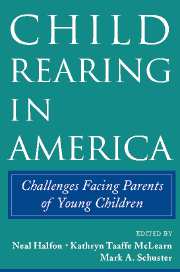Book contents
- Frontmatter
- Contents
- Tables
- Figures
- Contributors
- Acknowledgments
- 1 Introduction and Overview
- PART I CONDITIONS OF FAMILIES WITH YOUNG CHILDREN
- PART II CHILD-REARING PRACTICES
- 4 Meeting the Challenges of New Parenthood: Responsibilities, Advice, and Perceptions
- 5 Reading, Rhymes, and Routines: American Parents and Their Young Children
- 6 Child Discipline in the First Three Years of Life
- 7 Breastfeeding in the United States Today: Are Families Prepared?
- 8 Depressive Symptoms in Parents of Children Under Age 3: Sociodemographic Predictors, Current Correlates, and Associated Parenting Behaviors
- PART III DELIVERY OF HEALTH SERVICES TO MOTHERS AND CHILDREN
- PART IV FUTURE DIRECTIONS AND POLICY IMPLICATIONS
- Index
- References
8 - Depressive Symptoms in Parents of Children Under Age 3: Sociodemographic Predictors, Current Correlates, and Associated Parenting Behaviors
Published online by Cambridge University Press: 15 July 2009
- Frontmatter
- Contents
- Tables
- Figures
- Contributors
- Acknowledgments
- 1 Introduction and Overview
- PART I CONDITIONS OF FAMILIES WITH YOUNG CHILDREN
- PART II CHILD-REARING PRACTICES
- 4 Meeting the Challenges of New Parenthood: Responsibilities, Advice, and Perceptions
- 5 Reading, Rhymes, and Routines: American Parents and Their Young Children
- 6 Child Discipline in the First Three Years of Life
- 7 Breastfeeding in the United States Today: Are Families Prepared?
- 8 Depressive Symptoms in Parents of Children Under Age 3: Sociodemographic Predictors, Current Correlates, and Associated Parenting Behaviors
- PART III DELIVERY OF HEALTH SERVICES TO MOTHERS AND CHILDREN
- PART IV FUTURE DIRECTIONS AND POLICY IMPLICATIONS
- Index
- References
Summary
Depressive symptoms are quite prevalent among adults in the United States. Eaton and Kessler (1981), reporting on a nationally representative sample of 3,000 households, found that 20.7 percent of adult women in the U.S. and 10.9 percent of men reported depressive symptoms over the level for possible clinical depression (for comparable data, see also Comstock and Helsing 1976). In contrast to rates of depressive symptoms, rates of current, psychiatrically defined depressive disorders, including major depressive disorder and dysthymia, are much lower (5–8 percent), in part because a psychiatric diagnosis requires the application of several simultaneous criteria, including a specified duration of depressive symptoms (American Psychiatric Association 1994; Robins and Regier 1991).
The literature suggests that the stresses of parenting may increase the risk of parental depression. In addition, a large body of evidence indicates that parental depression increases the vulnerability of children to a variety of negative developmental outcomes, including poorer problem-solving skills, impaired social competence, and increased rates of psychiatric disorders (Beardslee et al. 1983; Cummings and Davies 1994; Downey and Coyne 1990; Zuckerman et al. 1987). Risks to children are found whether parental depression is assessed on the basis of current depressive symptoms or psychiatric diagnostic criteria for depression. In studies that have included both types of assessments, the chronicity of parental depressive symptoms over time has been a more sensitive predictor of child dysfunction than the parent's current or prior history of depression meeting psychiatric diagnostic criteria (Campbell et al. 1995; Lyons-Ruth 1992).
- Type
- Chapter
- Information
- Child Rearing in AmericaChallenges Facing Parents with Young Children, pp. 217 - 260Publisher: Cambridge University PressPrint publication year: 2002
References
- 39
- Cited by

